If you’re looking for an interesting and exotic plant to add to your garden, then consider Alocasia black velvet.
This tropical plant has dark green leaves with a velvety texture that gives it its name.
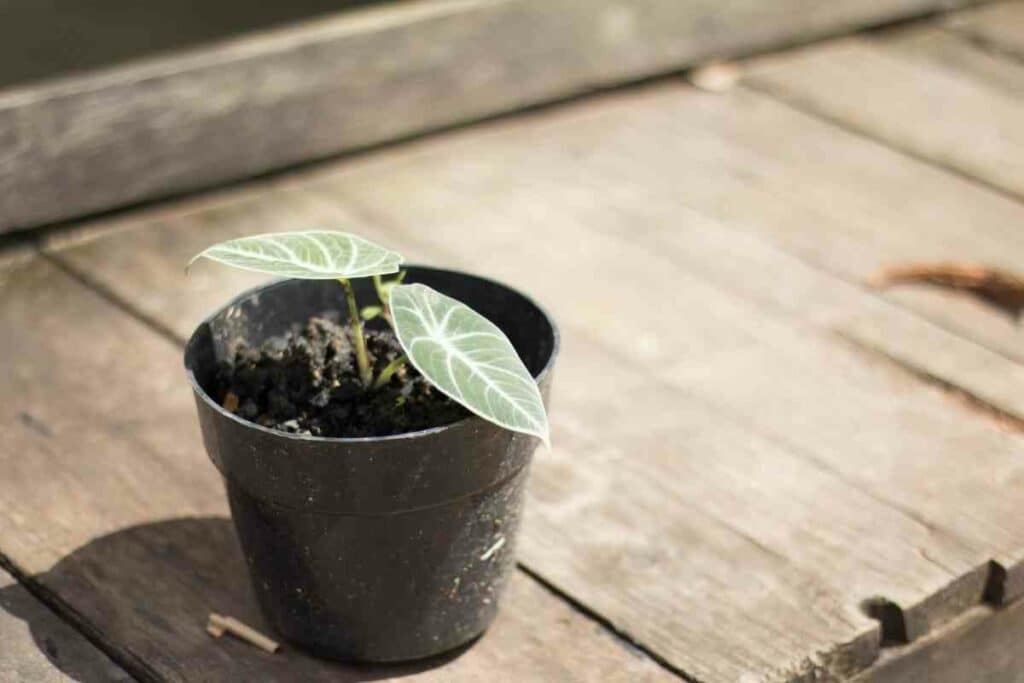
It’s easy to care for and can be grown indoors or outdoors.
Keep reading for a guide on how to care for Alocasia Black Velvet in your garden.
About Alocasia Black Velvet
Black Velvet, or Alocasia Reginula, is a tropical plant that is native to Southeast Asia.
It was first discovered in Malaysia by English botanist, Nathaniel Wallich.
The plant gets its name from the black color of its leaves and the velvety texture.
Black Velvet is part of the Araceae family which contains around 2800 species of plants.
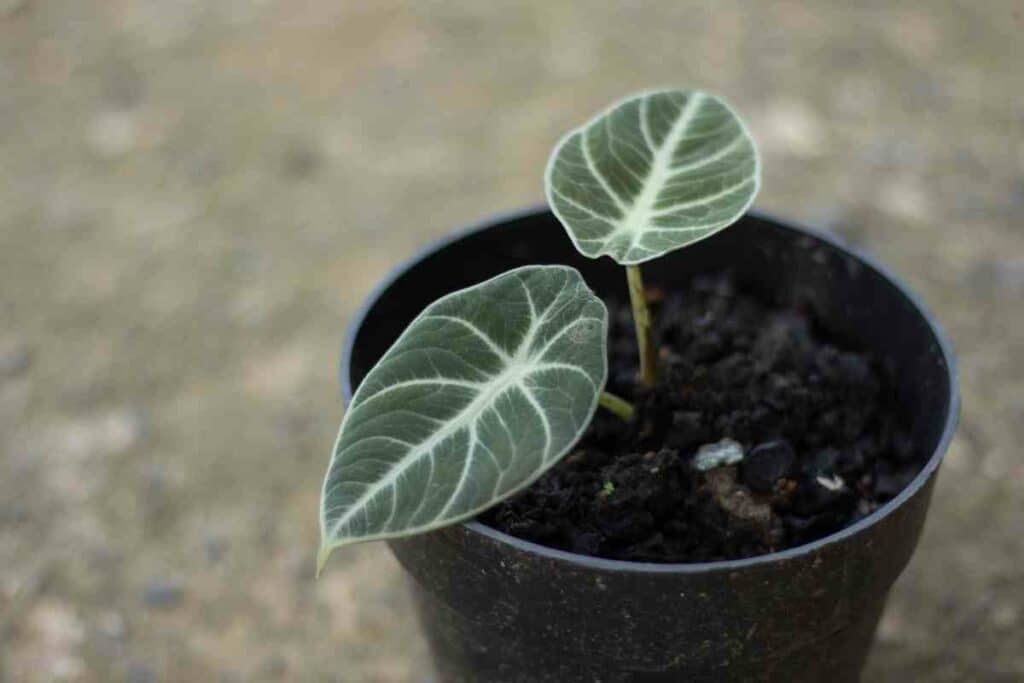
The plant can grow up to 3 feet tall and 2.5 feet wide. It prefers shady areas and moist soil.
Black Velvet is a fast-growing plant and can produce new leaves in as little as two weeks.
The plant produces small white flowers that bloom in the summer. However, these flowers are not very showy and are often hidden by the leaves.
USDA Zone
Alocasia Black Velvet grows the best in USDA zones 10 or above.
Only a small percentage of the United States falls into these zones, but California down to Arizona, the southern edges of Texas, and the southern half of Florida are all considered to be USDA zones 10 or higher.
Is it Poisonous
All plants are not created equal.
Some plants are poisonous, some are edible, and some are both. What makes a plant poisonous?
There are a few reasons why a plant might be poisonous.
Some plants contain chemicals that can harm your body if ingested.
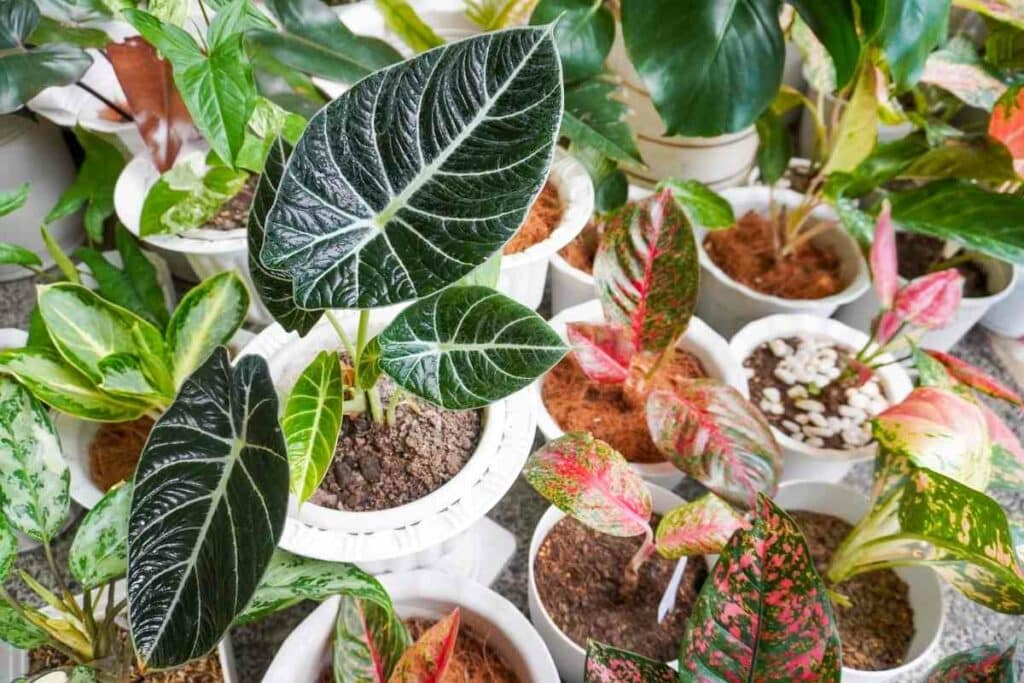
Other plants might be poisonous because they contain high levels of toxins that can be harmful if you come into contact with them.
In the case of Alocasia, any varieties including black velvet, the leaves contain a poisonous crystal.
Heads Up! When a pet, or even a human, takes a bite out of a leaf it causes irritation and swelling in the mouth, esophagus, stomach, and intestines.
If the throat swells too much, you or your pets could have difficulty breathing.
This is why you should see a doctor or bring your pet to the vet if you notice bite marks on the leaves.
Caring for Alocasia Black Velvet
Alocasia black velvet isn’t a good plant for beginners, but if you know how to find the perfect conditions you will do just fine.
All you have to do is follow this growing guide and your alocasia black velvet will thrive.
Water
Alocasia black velvet loves water, but the roots don’t like sitting in it.
They don’t need to be watered as often as you would think a water-loving plant would need to be watered because the leaves hold onto moisture for the plant to use.
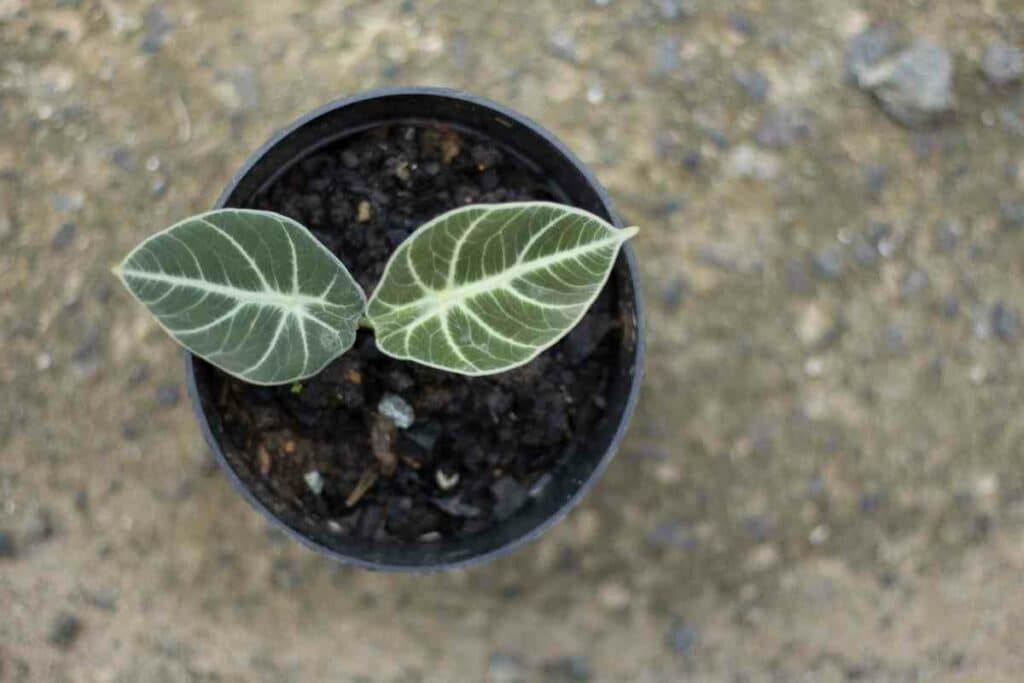
You should only water your alocasia black velvet when the soil is dry to the touch, and only water enough to dampen the soil.
Soil
Speaking of soil, it should be course to give the roots plenty of room to grow, well-draining to stop the roots from sitting in water, and slightly acidic with a pH of 5.5 to 6.5.
To get the perfect substrate for alocasia black velvet, try finding a soil with a mix of some of these:
Sunlight
Alocasia black velvet-like being in bright, indirect light.
Try keeping these plants out of windowsills, in front of windows where the sun might beat down on them for too long during the day.
The amount of sunlight your alocasia black velvet gets will affect the size and shape of its leaves.
If the plant isn’t getting enough light, the leaves will be smaller than normal, and the plant will start reaching toward the light becoming leggy.
Too much sun will also leave the leaves smaller than normal because they will be damaged and no longer able to grow.

If you notice the leaves of your alocasia black velvet starting to curl, this is the first clue that your plant is getting too much sunlight.
What’s happening when the leaves curl is the water from the stores in the leaves is drying out and the leaf doesn’t have enough support to keep its structure.
Fertilizer
Alocasia black velvet plants aren’t heavy feeders.
When your soil starts to become hydrophobic signaling that nutrients need to be replaced, you can start using an all-purpose fertilizer at half strength, or even quarter strength.
This diluted fertilizer should be applied once a month from spring until fall. It may not seem like a lot, but this is all your plant needs.
Temperature and Humidity
Alocasia black velvet plants like it warm and humid.
The ideal temperature for these plants is between 65-75 degrees Fahrenheit.
They also like the air to be humid, which can be achieved in a few different ways.
You could mist your plant every day, or you could put it on a pebble tray. A pebble tray is a shallow tray filled with pebbles and water.
The water will evaporate making the air around your plant more humid.
You could also use a humidifier, or put your alocasia black velvet in the bathroom while you shower to take advantage of the steam.
Pruning
There are two parts of the plant you should snip off, but the alocasia black velvet plant doesn’t need regular pruning like some other plants.
The first thing you are going to want to cut off is dead leaves.
Once a leaf is damaged, the plant will put its efforts into creating new leaves to replace it.
Save your plant some struggle and get rid of the leaf so all efforts can go towards new growth.
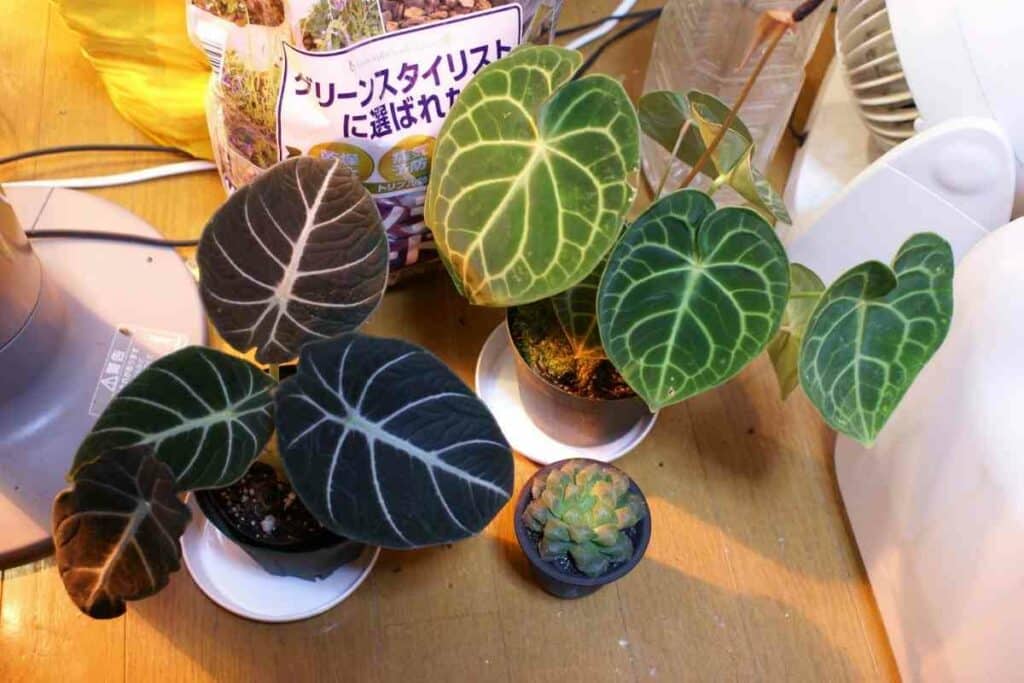
The other thing that should be cut is flowers.
Flowers rarely bloom, and while this may sound like a nice treat, they aren’t anything pretty to look at.
The flowers must know they aren’t very pretty because they typically hide under the large velvety leaves.
When flowers start growing, your plant is going to use up more nutrients and water keeping the flower alive, and will spend fewer resources on the leaves, which should be the primary goal.
Growing in a Pot
Growing alocasia in a pot is the same as growing it in the ground, maybe even easier.
Using a pot allows you to move the plant out of the sun, easily change up the landscaping in your backyard or porch, and add a level of interest depending on what type of pot you choose.
With a lot of plants, you’re told to repot into a larger pot every six months to every year. This gives those plants more space for the roots to grow resulting in a larger plant.
With the alocasia black velvet you should only repot every two years, and only go up a single size.
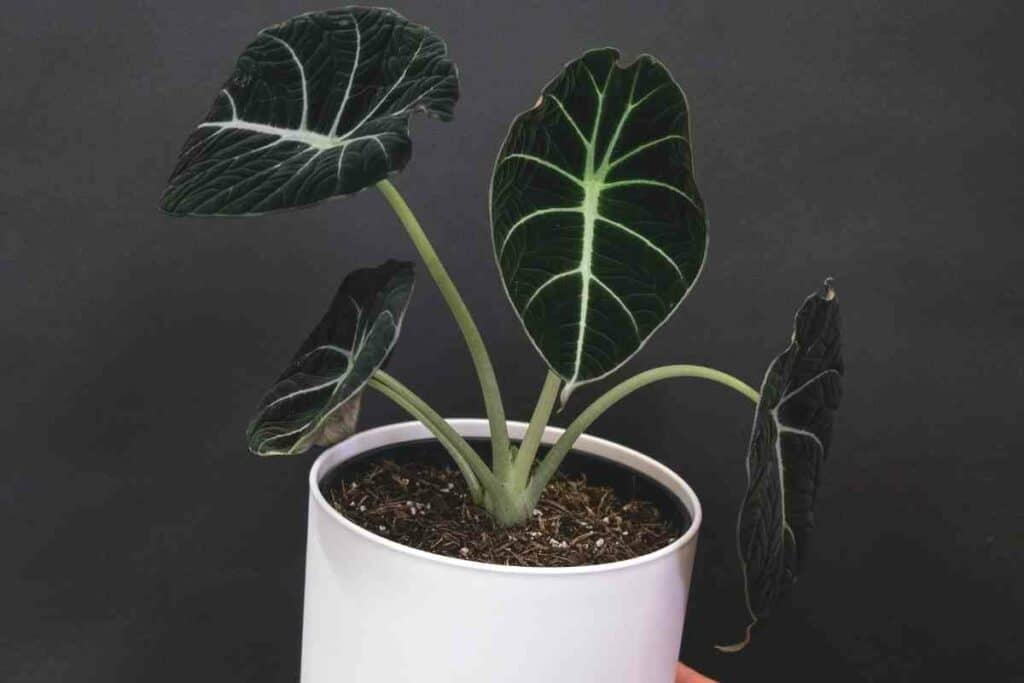
Alocasia plants would much rather be rootbound than in a pot that’s too big.
When you repot your plant, this is a good time to remove any offshoots from the plant. Those offshoots can be planted in a smaller pot so you get another plant.
You should also repot alocasia black velvet in the early spring before the growing season starts but after any potential dormant phase.
This way when the plant is put in the new pot, the roots will grow to fill the pot to support the plant.
Fixing Common Issues
These plants are pretty difficult to kill, but there are a few things that could go wrong, and here are some ways to spot those problems and fix them.
Plant Damage
Take a look at the leaves on the plant.
They will show you what the plant needs in different ways.
Brown Leaf Edges
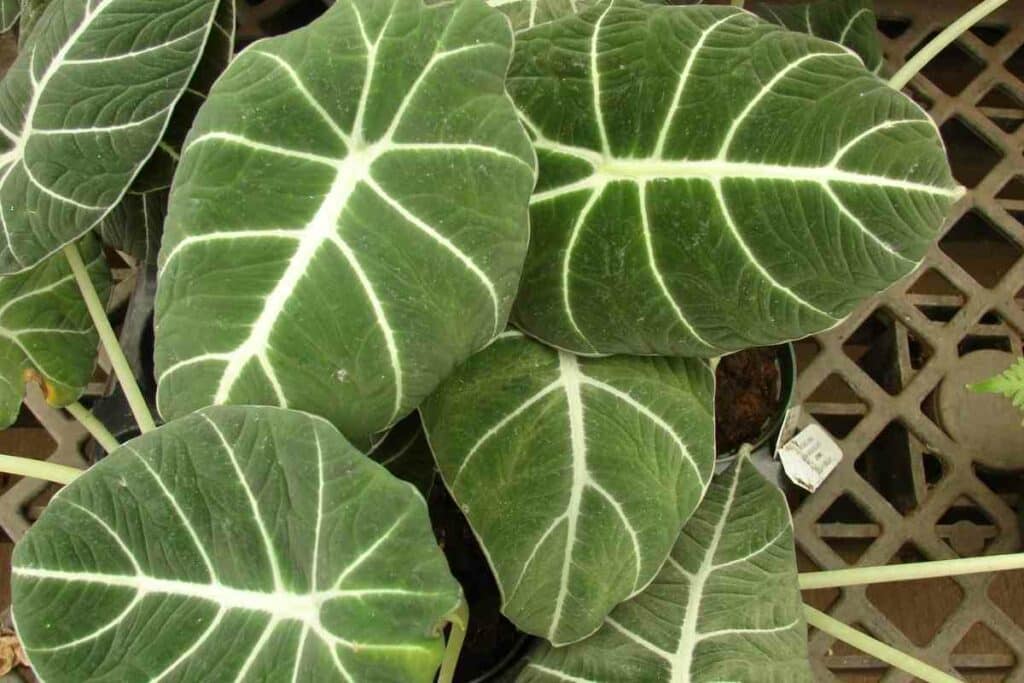
If your house is extremely dry, the edges of the leaves will start to dry out leaving behind a crispy brown edge.
If this happens, try to place a humidifier or a humidity tray by your alocasia black velvet.
Brown Leaf Tips
If the tips of the leaves turn brown you are over-fertilizing your plant.
You may think there might not think too much of a good thing could be bad, but nutrient overload can cause root burn and leaf burn.
You can choose to wait this out and use less fertilizer during your next feeding, or you can repot the plant if it starts getting worse.
Brown Spots
Brown spots are a sign that your plant has developed a fungus or may have a pest infestation.
If you don’t see any insects and you suspect it might be a fungus, make this mixture and spray it lightly onto the affected leaves:
- 1 gallon of water
- 1/2 teaspoon of liquid dish soap
- 1 tablespoon of baking soda
Curling Leaves
Alocasia black velvet leaves will start to curl if the plant gets too much sunlight.
If the plant is in your yard, you’ll have to dig it up and find a new less sunny spot for it, but if it’s in a pot you can easily pick it up and move it somewhere that receives less sunlight.
Yellow Leaves
You’ll quickly notice if your dark black velvet leaves begin to turn yellow.
This is a sign of root rot and could mean your roots are sitting in water.
Allow the plant to fully dry out, and then decide if you should change the soil or cut back on watering.
Pests
There’s only one pest that loves to infest the alocasia black velvet plant; spider mites, and they are fairly easy to identify.
If brown spots appear in the middle of the leaves of your plant, it is very likely to be pest damage.
Brown spots may not show up easily on the dark alocasia leaves.
Spider Webs
If you take a look in the creases where the leaves grow out of the stem, you might notice very delicate spider webs.

It may even look slightly like mold because it’s so fine.
There are two ways to prevent spider mites from taking a liking to your plant in the first place:
- The first is keeping your leaves dust-free. This is definitely harder with the velvet texture of alocasia plants, but by using a damp cloth and wiping the dust off the leaves, you’re making a less hospitable home for the pests.
- You can also increase humidity to help keep the spider mites away. Spider mites dislike humidity, and since your alocasia black velvet loves it, why not do double duty and boost the humidity around your plant.
Luckily, spider mites are easy to get rid of, it just needs a little consistency.
All you need is a miticide.
Simply spray the leaves and soil around your plant to kill the mites.
If you can’t find a miticide, you can make your own by following these simple steps:
- Mix 1 tablespoon of cinnamon, ground cloves, and Italian seasoning in 1 gallon of water.
- Boil the water for 10 to 15 minutes.
- Remove from heat and add 1 tablespoon of minced garlic.
- Allow the mixture to cool completely.
- Strain the mixture.
- Add a few drops of liquid dish soap to the mixture and pour the liquid into a spray bottle.
- Shake well and spray the bottoms of the leaves every few days until the mites are completely gone.
Final Thoughts
Alocasia black velvet is a beautiful and unique plant that can be found in tropical rain forests.
It has large, dark green leaves with deep purple veins that run throughout the leaf. The leaves are velvety to the touch, which is where it gets its name.
This is an easy plant to care for and is a great addition to any indoor or outdoor space.
These plants are perfect for those who are just starting to care for houseplants, as well as those who have been doing it for years.
With the right amount of water, light, and fertilizer, you can have the beautiful velvety plant growing in your own home.


